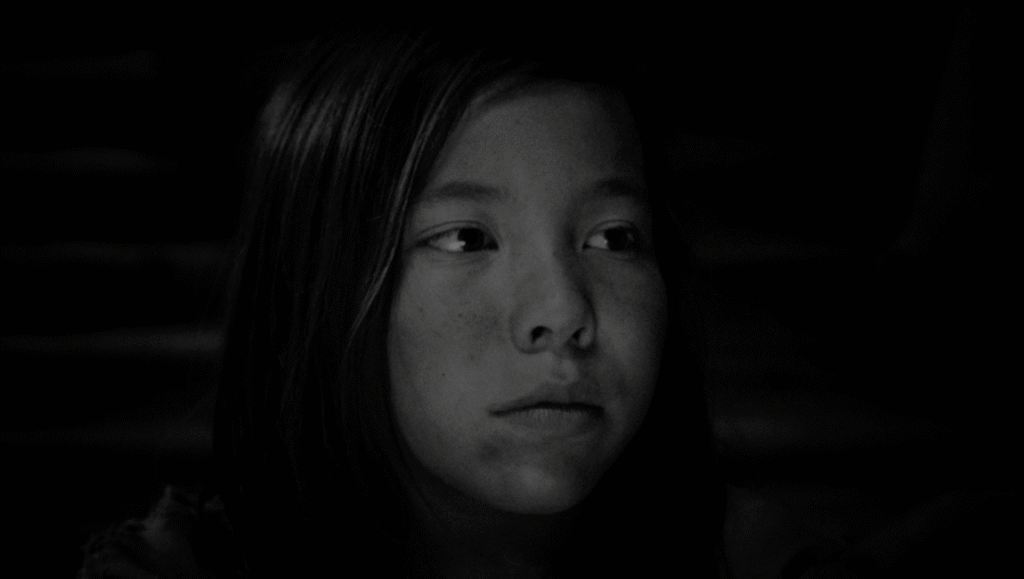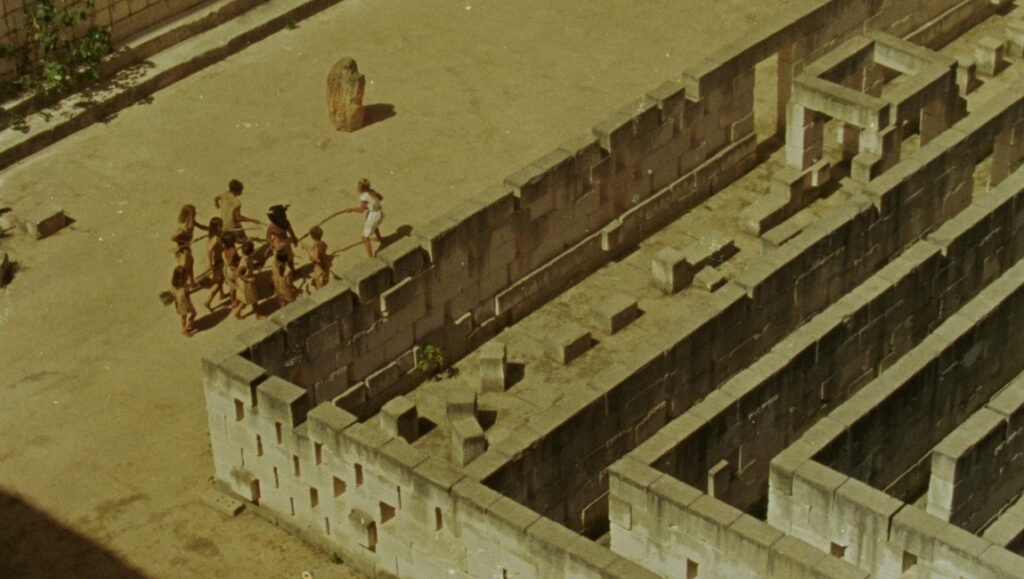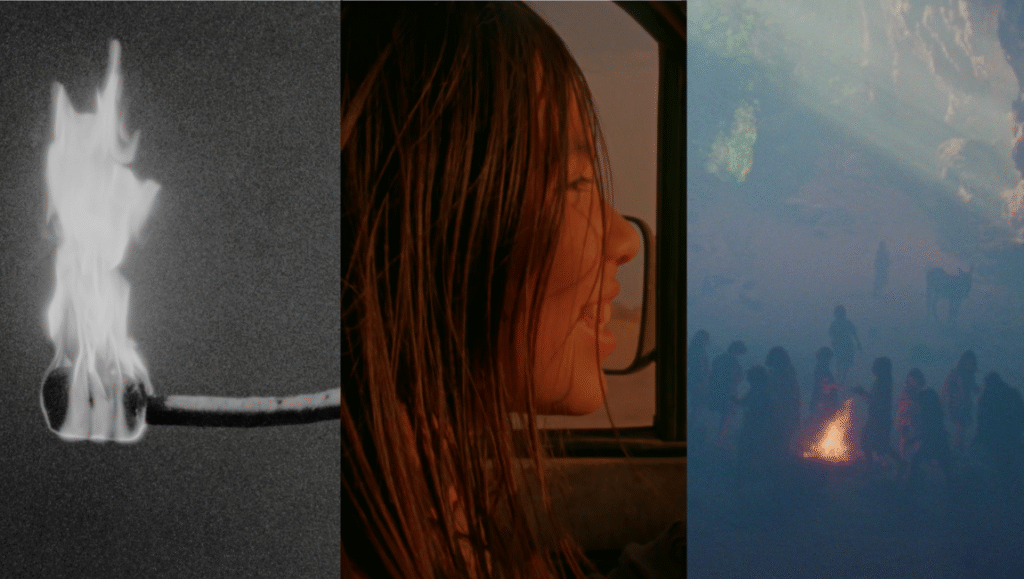In Mare’s Nest, director Ben Rivers takes us through a world moving beyond language. Inspired, in part, by a one-act play by Don DeLillo, Mare’s Nest takes place in a world without adults. The film opens before golden hour, a young girl named Moon (Moon Guo Barker) emerges from a crashed car. Throughout the film she’ll wander alone, or with other children, through landscapes that seem pre- and post-history. Hints of the old world emerge — crashed cars, a labyrinth in ruin — but the children forge forward in reimagining a new way of living. Shot in a mix of color and black-and-white Super 16mm, Mare’s Nest glows with warm tones and textures that take on a life of their own.
Structured around two parts, the first half of the film takes large inspiration from DeLillo’s play, The Word for Snow. The film also features excerpts from Fernando Pessoa’s The Mariner, as well as writing from Daisy Hildyard and April Carrasco Tomàs. The children work through dense dialogue heavy with anxiety and uncertainty, with youthful spontaneity. The language-forward first half slowly gives way to the increasingly wordless second, as rigorous framing, performance, and choreography also gives way to something looser, more liberated. The movie brims with imagination and feels like a living breathing work of art, driven by the perspectives and logic of children.
In Review Online reviewed Mare’s Nest as part of our 2025 Locarno Film Festival coverage. We sat down with Ben Rivers as part of the recent Festival du Nouveau Cinéma in Montreal.
Justine Smith: I watched your talk in New York, where you spoke about wanting to see the world through the POV of children, particularly amidst so much strife and uncertainty. Can you talk about that in terms of working with kids?
Ben Rivers: Like many people, the way the planet is changing is on my mind. It’s not just the climate, but politics, capitalism, all kinds of things that are interconnected. This is the world we’ve created and the world that we’re leaving to the children. During the pandemic, I was thinking, “God, what a nightmare it would be to be a child locked inside an apartment in London or wherever,” because my upbringing was very free. It was in the countryside.
I’ve been interested in adults especially, who have found ways of finding freedom and different ways of being in the world that aren’t necessarily conventional. All these things were accumulating, and I was thinking, I would really like to work with children. I’d made a film before with kids, in 2008, and I wanted to get back to that energy. Kids before they reach a certain age, around twelve, they’re not thinking so much about society. They have a special kind of freedom and especially a freedom of the imagination to reinvent the world. I just find that really exciting. Then, I sort of imagine a world without adults. What would that look like? I wanted to make a sort of opposite Lord of the Flies, even though I love Lord of the Flies. I don’t want to presume that humans inevitably end up with conflict.
JS: I also love Lord of the Flies, but I also return often to that story — I don’t remember where it took place — where a bunch of children were stranded. They didn’t turn on each other, they were actually very caring and looked out for each other. Children can be mean, but I think fundamentally they want to work and play with each other.
BR: There were some kids left on an island for about a year and a half. They were from the South Pacific, I think. They looked after each other and got along. I read a big article about it recently, about the Captain who found them. It was amazing. There’s this idea that we are innately a species that will end up with conflict. I just don’t want to believe it. I mean, there’s a lot of evidence that says we are like that, but I just wanted to imagine an alternative — which also means making a film without conflict, which as you know, doesn’t follow the rules of scriptwriting either. You’re told that films need conflict and resolution. I’m thinking about radical children and framing that within a radical form.
JS: This film takes place in the post-apocalypse, but there’s something interesting about how the beginning and end of humanity begins to look a lot alike.
BR: I’ve always been fascinated by early humans and Indigenous cultures that lasted thousands and thousands of years. It’s so much longer than so-called Western capitalism culture, which is quite short and already eating itself. For me, it’s a bit of mixing between early humans who lived with the planet, you know, who consider themselves part of nature rather than separate to nature and regaining some of that. But yes, they are also post — these kids are living in a post-apocalypse or post-collapse, post-something. There’s all the evidence. Cars are left over, but they no longer have importance.
We had costume designers working to make the clothes, and they did them with the kids. We did this workshop, where all the kids just had piles and piles of old clothes and bits of plastic and stuff left over from the beach. Kids could then tear apart these clothes and reassemble them, add adornments. It’s all stuff from the past that then gets reused. Objects get new meanings and their original usage is forgotten.
It’s this world from the play. The translator says, “we’re outside history.” That’s the world that I’m trying to get at with them. I feel like they’re trying to forget the past and reinvent the world completely, but that’s also confusing. There’s still an underlying unease to it, there’s still danger. Who knows which way it goes? Maybe it could go wrong. Some communities might end up going in a loop and ending up with the same problems we have. The idea is at least they’re having a chance to rethink things.

JS: You also have the scene with the minotaur and the labyrinth. It reminded me a lot of Pasolini, whose films often feel outside of time.
BR: I always loved the way he mixed different time periods. Hundreds of years happen in Pigsty; you’ve got the contemporary and the medieval. It’s not completely, convincingly medieval. I’m sure he seeps into me, in my subconscious. He’s a filmmaker who is so free. The way he works with non-actors as well is really important. That’s something I’ve probably learned from, as well as other filmmakers who use non-actors. I generally don’t work with actors because I really like the realness of a non-professional actor — there’s just a different way of being in front of a camera. If you can get people to relax, it adds a different kind of reality to the scene.
JS: Is it easier or harder to work with children in that sense?
BR: Easier, I’d say. I had such a good time and zero problems with the kids. I decided to work with kids roughly between the ages of seven and twelve because although kids these days are more image-savvy earlier because of phones, they don’t care that much until the point where they go to secondary schools. They’re very much their own people and super intelligent. They’re still children, they’re free to play and they’re not held back by any kind of societal pressures. Then puberty hits and pressures start hitting. I found them very open and easy to work with.
The film is split between very scripted scenes, which they took very seriously and practiced and worked very hard to achieve. Then a whole bunch of the film is improvised. It’s sort of setting up situations or scenes, but then allowing them time and I can let them play it out. A number of times we slowly work through the choreography for a scene. Sometimes with Moon, I don’t even rehearse. I just say to her, “I want you to wander around a room and look at things, do what you feel like and I’m going to follow you.” There’s a risk, but sometimes the first take is great because she’s so at ease and she does what she feels like as she would if she went without a camera.
JS: What is it about the play by Don DeLillo that appealed to you?
BR: I’ve been a fan for a long time, and I also like the 21st century ones, which got shorter and more terse. The play is part of that move. While I was thinking about this film and imagining this film, I came across the play quite by accident. It was published in a book by a gallery in New York. I read it and wanted to do something with it. I thought maybe I could just put it on in London as a play. But because I was thinking about these kids at the same time, I thought, “Actually, wouldn’t it be amazing to have three kids read this?” It could be really powerful. Once that idea had come into my mind, I couldn’t get rid of it. It was really persistent. It was actually the first thing I filmed in the whole film because filming was kind of broken up. It was quite fragmented.
The play speaks to all these anxieties that I think a lot of people share. It also talks about language. It talks about the loss of things, also the loss of language, how everything disappears. I thought that mirrored what I was thinking about more broadly in the film. The spoken language happens more in the first half of the film and starts to disappear, like they’re moving beyond everything. By the end, her last encounter, they no longer need to speak at all. They understand each other.
JS: I’d love to know more about the cave. Where did you find it? There’s also this really spectacular shot about 45 minutes into the film, where we watch the children from above. Can you talk about that moment?
BR: It’s an amazing place, and it’s in Menorca. I ended up in Menorca seeing the quarry that has the labyrinth. Then thinking, okay I’m going to make a version of the Minotaur with the kids. I went to just look at that place. Then I met somebody called Pep [Salvador] who ended up being integral to the film. He took me around Menorca, showing me a lot of different locations. I said, I want to find caves, underground spaces, ruins. “Show me what you’ve got.” He took me to all these amazing places. Sometimes locations and landscapes can really help inform the film in the writing period. It really helps me. Once you’ve got some images of places, you can imagine things within them. That’s what happened with that place.
Once I got to the back of the cave and looked down, I probably saw Pep just walking around while I was up there and thought, “this could be amazing to see a group of kids come in and start doing rituals I don’t understand, that none of us understand.” They’re kind of doing their own thing as a group or small little groups within the bigger group. We did that. We had a lot of time so we could try things out and then eventually film it. They each had things to do, but I wasn’t too strict. There’s a thing about improvising, you need markers, but also freedom to not feel like you have to be so precise to the thing that you’ve done before. It’s like music.

JS: This is a more general question and you can answer how you want. I’m very curious about what it means to be a working filmmaker, a working artist. I don’t want to make assumptions, but I assume you are working class. You have to work to survive. What does your work do? It can be a day, or a year. I feel we don’t often talk about labor in cinema in terms of making a living.
BR: Daily, it’s so intertwined in my life. It’s not like I have my job as a filmmaker and my life. They’re so deeply intertwined. Almost everything I do is somehow related. The fun part of making a film is filming. It’s the most exciting, even if it’s also often the most stressful. Then there’s just so much grunt work before and after a film; raising money, answering untold emails, planning productions, trying to get people involved. Then, once you finish a film, the post-production and everything, then you’re on the road trying to hold its hand out in the world, doing interviews and traveling to festivals. Meanwhile, you’re trying to get the next one going. It’s kind of non-stop. I really enjoy it, but I like to layer films as well. I don’t tend to work on just one film at a time because I don’t really like gaps.
JS: You also still make short and medium-length films.
BR: That’s usually if there’s a commission or something that comes up. Actually, I’m doing one right now. Even in my hotel room here I was playing with the edit last night.
Luckily, I have a partner who is also a filmmaker and a photographer who understands this life, because it’s very hard to turn off. It’s certainly not a 9-to-6, but it’s the life I chose and I do enjoy it.
JS: You mentioned earlier freedom in terms of how you make films. So is it also, I guess, freedom and how you live?
BR: I think there is a lot of freedom. Sometimes there’s financial precarity. I’m not from a rich background that sustains my life. Now it’s okay, I’ve been doing it a long time and I know how to juggle everything, but it was complicated at the start. It was quite a big decision to say, “I’m going to live like this with freedom.” But that also means you don’t necessarily know how you’re going to fund your life.
JS: Were you working non-film jobs at the beginning?
At the beginning I was doing all kinds of jobs. I worked as a sous chef in a restaurant. That’s really tiring. I did nightclub visuals. I worked for a company called Snow Business that did fake snow for big films. I ran a cinema. I was teaching a bit. I did quite a lot. My 20s were very busy, and, actually, I didn’t make that much in my 20s. When I turned 30, I was like, I need to stop a bunch of this stuff and try to just be a filmmaker. It was risky, but I thought, if I keep doing so many different jobs to sustain myself, that’s also not going to do, because you get sucked into doing all those things. I just went through it and somehow it worked out.
I still do camerawork sometimes for people, usually people I really like or a project I like, but that pays me something. I do some fashion stuff. From when I was a child when they asked you, what do you want to do? I knew I didn’t want to do a 9-to-5 job.


Comments are closed.